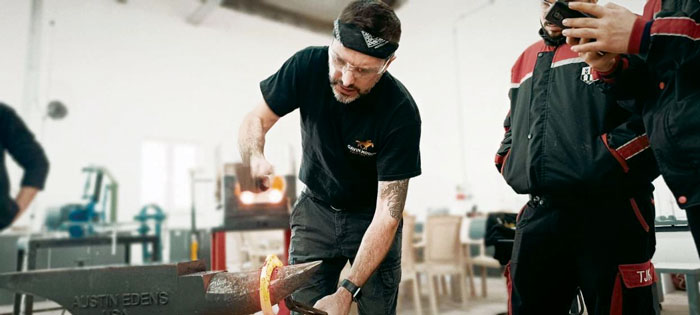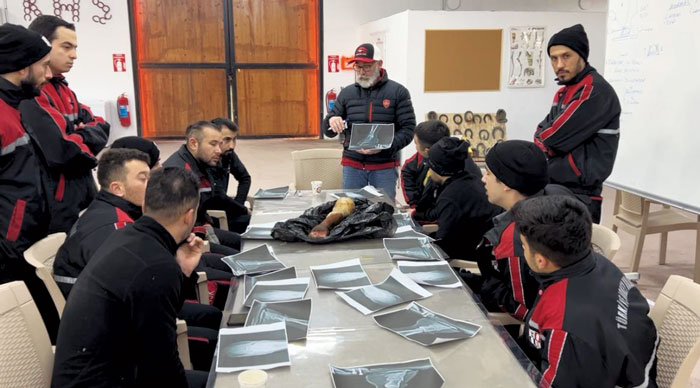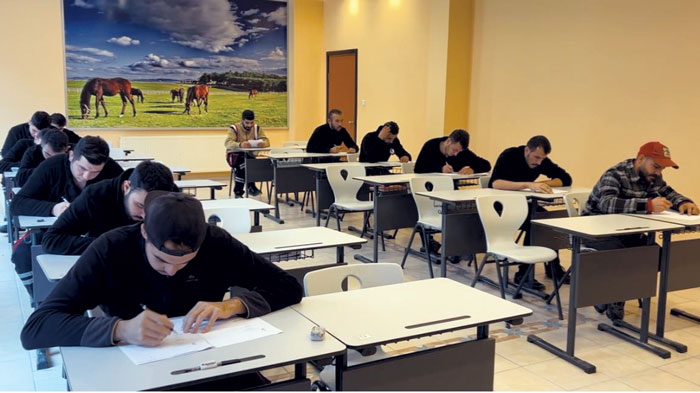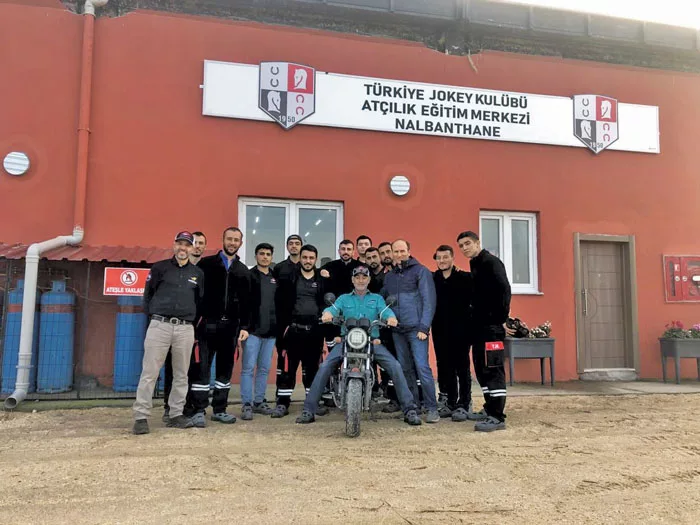Turkey’s first official farrier school opened its doors in November 2023, a project Hall of Fame farrier and Kentucky Horseshoeing School founder Mitch Taylor had been working on for some considerable time.
Taylor has been visiting Turkey and providing education for several years. During this time, he built a strong relationship with the Turkish Jockey Club (TJK). Through this mutual respect and understanding of the need for improved farriery skills and knowledge, a collaboration between the Kentucky Horseshoeing School and the TJK was born.
Birth of the School
The TJK Farriery School was founded in a part of Turkey known as Karacebay, a 10,000-acre stud farm with many private- and TJK-owned bloodstock. It also holds a training development scheme for future jockeys and racing personnel.
Through Taylor’s extensive knowledge of farriery education, a program was created to cater to 12 students who were chosen from 50 candidates to be the first class trained in developing hoof-care-related skills and a higher understanding of anatomy, disease and pathologies.
I met Taylor a few years ago upon visiting America for the first time to attend the International Hoof-Care Summit. I traveled to the United States with Simon Curtis, PhD, FWCF, HonAssocRCVS, who not only is a good friend but was my boss many years ago. He remains my mentor to this day. Through their friendship, I was fortunate to be introduced to Taylor in 2020 at Kentucky Horseshoeing School. This connection led to Taylor and I agreeing on an international collaboration between KHS, TJK and Gavin Moody Farriers, Ltd. when I agreed to be the instructor.
Takeaways
- The Turkish Jockey Club Farriery School educates a class of 12 students over 24 weeks.
- The intensive training, led by Gavin Moody and Mitch Taylor, includes all aspects of equine hoof care, farriery, foal podiatry, anatomical knowledge and shoeing theory.
- Onsite veterinary surgery exposes students to pathologies almost immediately.
My experience lies mainly in the horse racing industry aspect of farriery. I come from a small town called Newmarket, United Kingdom, which is known worldwide as the center of the horse racing world. I have more than 30 years of experience working at the forefront of British racing, and I run a multi-farriery business employing qualified farriers and apprentices. I have been privileged to travel to many countries shoeing and plating racehorses for specific international races.
Farriery education and development is a big part of my life. When Taylor asked me to come on board, it was exciting but also daunting, to say the least.
Opening Bell
Initially, the TJK established a vetting process in September 2023 to establish which 12 candidates from a possible 50-plus applicants would be granted a position at the school. Taylor and I sat on a panel of judges that included leading TJK board members and the school principal. The students selected came from all over Turkey. A small number had previous experience with horses, but the majority didn’t.
Twenty-four weeks of intensive training in all aspects of equine hoof care, farriery, foal podiatry, anatomical knowledge and shoeing theory was taught to the selected candidates. It’s hoped that in time a continued development system will be incorporated.
“The quality of craftsmanship in such a short space of time is overwhelming…”
The program involves classroom-based lecturing and educational techniques first thing in the morning, aimed at providing the students with a wide range of farriery-based knowledge. When I first agreed to be part of Taylor’s plans, I wondered how it would be possible to communicate this information to the students in a manner they would understand due to translation issues. I was surprised by the amount of not only fundamental knowledge they soaked up, but how they absorbed a much higher level of understanding of anatomical structure, disease, lameness, conformation and biomechanics.
Once class work is done, we head to the workshop for a full day of practical hands-on learning. The workshop accommodates many horses at a time for the students and me to work on. The horses are mainly cold-shod; however, the students also have been working on their hot shoeing skills. The area is equipped with 12 propane forges and anvils, as well as a welding room that all of us would love to have at home.
Each day, in addition to their educational and practical developments in farriery, the students are required to learn how to make shoes and modifying techniques to prepare them for any eventualities they may come across.
The hoof care, shoeing and shoemaking have been a pleasure to teach and watch their progression. You must realize that the majority of the students have no experience in farriery or horses. The quality of craftsmanship in such a short time is overwhelming, as well as witnessing their thirst for knowledge.

Gavin Moody forges a horseshoe during a demonstration for students. Photo by: Gavin Moody
Learning is often enhanced by the proximity of the onsite veterinary surgery. At times, when watching the horses work up and down before shoeing, I have pointed out various conformational issues and lamenesses associated with these faults. We have been extremely fortunate to have these horses assessed and often radiographed. This exposes students to certain conditions almost immediately rather than being confined to a classroom. The students better understand some of the underpinning knowledge after observing situations firsthand. I can’t emphasize enough how fortunate the students are to be able to gather this data at such an early stage of their careers. Often, it takes years for students to put together classroom-based learning with real-life scenarios.
The workshop is equipped with freezers stocked with cadaver specimens. Working with these are useful in the educational journey of new farriers. The cadavers enable them to make and fit various shoes and modifications safely. They also are invaluable in providing hands-on learning during dissections, a great way of transforming classroom-based learning into real-life learning.
It’s also extremely beneficial to have Taylor, one of the world’s most knowledgeable farriers on anatomical structure and position, perform dissections when visiting. It’s not only educational for the students and me, but also for the veterinarians, equine students and teachers based at the TJK. Taylor is well-known for his vast knowledge and dissection wet labs. Being able to watch and learn from him is an honor.

Mitch Taylor, center, reviews the anatomy of the equine distal limb. Photo by: Gavin Moody
Graduation
The 24-week course finished with a 75-question theory paper, practical shoeing tests and shoemaking assessments, welding tests, live horse observation and recognizing anatomical structures on a dissected limb, as well as a radiographic imagery test. This was in addition to the weekly proficiency tests we have given the students.
The credibility of the course was enhanced further when Curtis joined Taylor in examining the students during the last stages of the course.
The sheer level of comradeship during exam week was a privilege to be a part of. All the students stood tall and rose to the occasion, even though the thought of being the first farriery students in Turkey to take such tests was nerve-racking, not to mention the added pressure of two of the industry’s leading figures being the examiners.

Twelve students were chosen from 50 candidates to become the first class trained at the Turkish Jockey Club Farriery School to develop hoof-care skills and a higher understanding of anatomy, disease and pathologies. Photo by: Gavin Moody
Every student succeeded in passing the required elements, which was truly an amazing achievement in such a short time.
A graduation ceremony celebrated the students' dedication and development. Awards were given to the overall outstanding academic excellence, best shoe display and best shod pair of feet.
All 12 students will find employment within the TJK, hopefully taking with them a deeper understanding of the horse and farriery.
In summary, I’d like to thank Mitch and Sarah Taylor and the TJK for the opportunity to be involved in such a wonderful and fulfilling experience. Of course, I extend my gratitude to the students who have shown me that hard work and determination can achieve great things no matter the obstacles.








